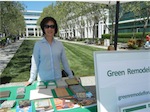Distributed renewable generation systems such as solar electric and solar hot water systems are great ways to get clean energy. The price of these systems, in particular solar electric systems, has come down in prices so much in recent years that homeowners may want to consider installing them.
While the energy generated is clean, the manufacturing process and disposal of renewable systems, however, still have environmental implications. The environmentally responsible way to make use of renewable systems is not to oversize the installations. That means first reducing your energy requirement. Here are some simple steps to achieve energy conservation and efficiency first.
- Turn lights off when they are not needed. Make a habit of turning lights off when walking out of the room or install motion sensors.
- Use compact fluorescent (CFL) or light emitting diode (LED) lamps. You can lower your lighting usage by at least 75%.
- Eliminate plug-load (phantom load). Plug computers, printers, television sets to a power strip so that you can turn all of them off with a flip of a switch.
- Install programmable thermostat to pre-set when you need it to turn on.
- Set the furnace thermostat at 68 degrees or lower in winter, and the air-conditioner thermostat at 78 degrees or higher in summer, health permitting. That can help save energy by 3-5%.
- Clean or replace air filters of heating and cooling system monthly or regularly as per product manual.
- Have a heating and cooling professional to maintain your system once a year.
- If it is time to replace your heating and cooling system, replace it with ENERGY STAR® labeled energy-efficient model.
- Defrost refrigerators and freezers before ice buildup becomes 1/4-inch thick.
- If you buy a new refrigerator, do not place the old one in the garage. Running an inefficient old refrigerator in a hot garage will cost you even more.
- Wash only full loads in a dishwasher and use the shortest cycle that will get your dishes clean. If operating instructions allow, turn the dishwasher off before the drying cycle and let dishes dry naturally.
- Install energy-saver showerheads.
- Set the water heater thermostat at 140 degrees or “normal,” if you have a dishwasher. Otherwise, set it at 120 degrees F or “low.” Check your dishwasher to see if you can use 120 degree F water. Follow the manufacturer’s direction on yearly maintenance to extend the life of your unit.
- Fix defective plumbing or dripping faucets. A single dripping hot water faucet can waste 212 gallons of water a month. That not only increases water bills, but also increases the gas or electric bill for heating the water.
- Seal all cracks and holes by caulking or spray foam to prevent air infiltration. However, be careful not to caulk around water heater and furnace exhaust pipes (for fire hazard reasons).
- Caulk around windows and doors where air may leaks.
- Insulate attic to R-38 level or better dependent on your climate zone.
- Seal heating or cooling ducts. Then insulate with R-8 or better duct wrap. For attic ducts, bury under attic insulation.
- Install shades, awnings or sunscreens on windows facing south and/or west to block summer heat. In winter, open shades on sunny days to help warm rooms.
- Replace old windows with new low-E dual pane windows.
Do you have other energy tips? Please comment.








